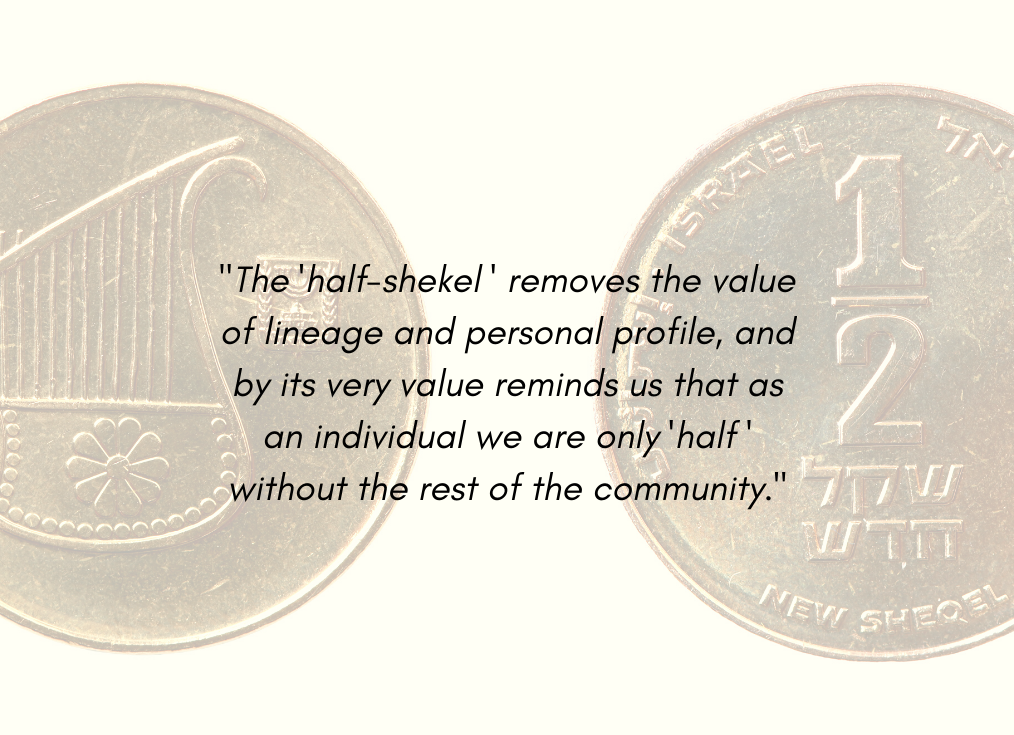Counting Half-Shekels

February 18, 2022
There is a constant tension between our “self” and our “community.” We are each distinct individuals with unique talents, skills, and attributes who offer independent contributions to the greater good. Yet, we are also each part of a larger community that unites and bonds us on common criteria toward a shared future. In other words, we struggle between Shakespeare’s infamous line from Hamlet, “This above all: to thine own self be true” and the aphorism, “A rising tide lifts all boats.”
In this week’s Torah portion, Ki Tisa, we read of Gd’s commandment for a census to be taken. Yet, the way the people are counted is oddly based on their contribution of a half-shekel. Each person over twenty is commanded to contribute a half-shekel and then these half-shekels are to be totaled in order to count the people. Why the extra step of counting the contributions, why not just count the people directly, are questions that our scholars have repeatedly asked over the generations.
Additionally, we read that “The rich shall not give more, and the poor shall not give less…” (Exodus 30:15). For obvious mathematical reasons, this requirement provided a clear calculation of adding all the half-shekels and then multiplying the total by two in order to calculate the final census number. It is the magic of this mathematical calculation from which we learn some very important lessons from this week’s Torah portion.
First, the claim that each person has an equal responsibility to contribute to the community is a telling statement, and the mathematical calculation that the community’s sum is twice as much as the collection of the individual amounts provides a clear message that “the whole is greater than the sum of the individual parts!”
Second, the fact that the rich and the poor contribute the same amount shows that each member of the community has equal value to Gd and that one’s wealth does not make a difference beyond this material world. No one has the capacity to carry their wealth beyond this lifetime so what we do with our wealth during this lifetime is how we will be judged when we face Gd at the end of our lives.
Third, and possibly the most important, is that a community is made up of everyone. The active and engaged are as important as the inactive and disengaged. The community elders have equal “value” as the young adults. The artisans are equally important to building a community as the judges. The “half-shekel” removes the value of lineage and personal profile, and by its very value reminds us that as an individual we are only “half” without the rest of the community.
Jews have survived longer than wealthier empires, stronger kingdoms, and more numerous dynasties. We have been singled out for genocide on more than one occasion, and yet we are still here today. The very concept of the minyan, the requirement of a minimum number of Jews to come together to create community is as much a part of who we are as our individual names and personal DNA. We cannot be Jewish without community and the community cannot exist without everyone being counted.
If you are reading this column then please share it with someone who might not be as “connected” as you. Encourage them to sign up to receive our Jewish community notifications. Let them know about all the amazing resources available to them in Jewish San Antonio. Connect them to the ongoing events that span everyone’s interests from art, music, Israel, political action, film and theatre, adult education, and so much more!
In the words of Helen Keller, “Alone, we can do so little; together, we can do so much.” So, what will each of us do this week to help make us…
STRONGER TOGETHER.
Shabbat shalom,

